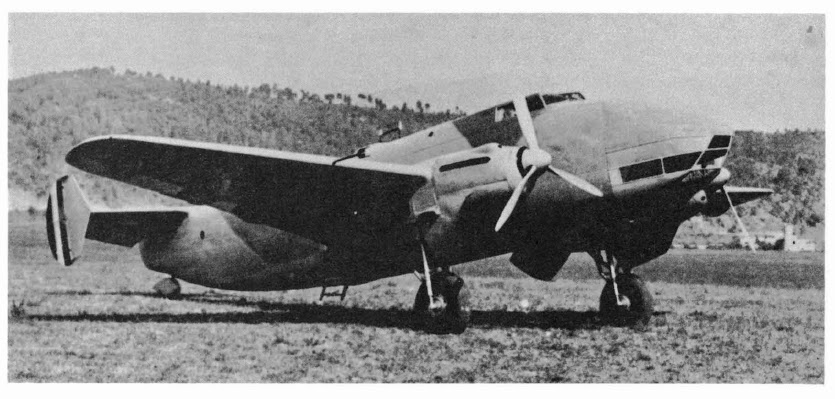The P.32-I medium bomber appeared in 1936 with 820
h.p. lsotla-Fraschini Asso XI R.C. water-cooled-engines. Visible here are the
semi-retractable dorsal and ventral machine gun turrets.
The Piaggio P.32 twin-engined bomber was a
roundabout development of the two P.23 prototypes; the reactivated Reggiane
firm also built experimental derivatives commencing in 1937. The Reggiane
machines, the Ca 405 record plane and its bomber conversion, the P.32bis,
featured the sleek contours associated with their P.23 predecessors, but the
Piaggio development (also rather confusingly designated P.32) was a more
practical all-wood military machine with a fuller fuselage of increased
capacity. Built in 1936, the original model, the P.32-I, was powered by 820 h.p.
Isotta-Fraschini Asso XI R.C. twelve-cylinder water-cooled vee engines and had
retractable dorsal and ventral gun turrets just aft of the wings. In 1938 a
revised version employing 1020 h.p. Piaggio P.XI R.C.40 fourteen-cylinder
radial engines was built, designated P.32-II. Except for the engines and the
supplementing of the two turrets amidships with a nose turret above the
bombardier's position, there were few changes. Crew was five in both models.
The internal bomb bay housed up to 3520 lb., while the wing (identical to that
employed by the' Reggiane variants) featured the characteristic double flaps.
Neither the P.32-I nor the P.32-II ever entered production.
The P.32-I weighed 12,650 lb. empty and
16,170 lb. fully loaded. Performance included a maximum speed of 248 m.p.h. at
16,400 ft., a landing speed of 78 m.p.h., and a service ceiling of 22,960 ft.
The bomber climbed to 13,120 ft. in 15 min. The more powerful P.32-II was
heavier at 13,640 lb. empty and 20,350 lb. loaded. It had a maximum speed of
264 m.p.h. at 16,400 ft. and a service ceiling of 26,240 ft Dimensions were:
span 59 ft. 0 1/2 in., length 52 ft. 5 3/4 in. (P.32-I, 53 ft. 5 1/2 in.),
height 17 ft., and wing area 634.8 sq. ft.




No comments:
Post a Comment